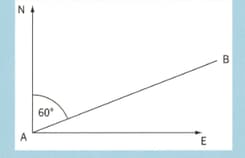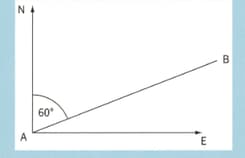Combining Velocities
Important Questions on Combining Velocities
A small aircraft for one is used for a short horizontal flight. On its journey from , the resultant velocity is in a direction east of north and the wind velocity is due north.

After flying from , the aircraft return along the same path from with a resultant velocity of assuming that the time spent at is negligible, calculate the average speed for the complete journey from and back to .
A small aircraft for one is used for a short horizontal flight. On its journey from , the resultant velocity is in a direction east of north and the wind velocity is due north. Show that for the aircraft to travel from it should point due east.

A Plane has an airspeed of due north. A Wind blows at from east to west. Draw a vector diagram to
The plane lies for . Calculate the displacement of the plane in this time.
A Plane has an airspeed of due north. A Wind blows at from east to west. Draw a vector diagram to calculate the resultant velocity of the plan Give The direction of travel of the plane with respect to north.
A river flows from west to east with a constant velocity of . A boat leaves the south bank heading due north at . Find the resultant velocity of the boat.
A vector of magnitude acts towards the right and a vector of magnitude acts upwards. What is the magnitude and direction of the vector ?
Which of the following pairs contains one vector and one scalar quantity?
A velocity of is due north. Subtract from it another velocity that is due west. Subtract from it another velocity that is due east.
A velocity of is due north. Subtract from it another velocity that is due west.
A velocity of is due north. Substrata from it another velocity that is due north.
A velocity of is due north. Subtract from it another velocity that is due south.
A stone is thrown from a cliff and strike the surface of the sea with a vertical velocity of and a horizontal velocity . The resultant of these two velocities is . Draw a vector diagram showing the two velocities and the resultant. Use your diagram to find the angle between the stone and the vertical as it strikes the water.
A stone is thrown from a cliff and strike the surface of the sea with a vertical velocity of and a horizontal velocity . The resultant of these two velocities is . Draw a vector diagram showing the two velocities and the resultant. Use your diagram to find the value of .

